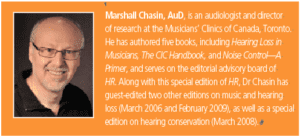Back to Basics | August 2014 Hearing Review
It happens almost every day. Someone comes up to me and asks, “What is the twelfth root of 2?” And of course, the answer is 1.059. The number keeps going on (an irrational transcendental number), but I figure that, for people who just come up and ask me a question, 3 decimal places is sufficient.
One of the many areas that have long kept musicians and audiologists apart is the terminology. Musicians use A, B, B flat, C#, and so on. Conversely, those in the hearing care field use 440 Hz, 466 Hz, and so on.
Clearly, there are advantages and disadvantages to both equivalent methods. In the letter method used by musicians, the same note (eg, A) can be used for octaves, whereas audiologists need to know how to multiply by 2. For musicians, an octave above A is still A; for hearing care professionals, an octave above 440 Hz is 2 x 440 Hz or 880 Hz. However, the numerical method provides exact information on the number of wavelengths passing a point in every second (ie, the frequency). And to make matters even more complicated, a musical note at A (440 Hz) not only has information (its tonic or fundamental) at 440 Hz, but also has higher frequency harmonics that can be either integer multiples of the tonic (eg, stringed instruments such as the violin) or odd number multiples of the tonic (eg, brass instruments such as the trumpet).
![[Click on image to enlarge.] Figure 1. A standard piano features 88 keys (white and black) representing notes that span from A0 (27.5 Hz) to C8 (4186.0 Hz), with “Middle C” or “C4” (in yellow) on the keyboard located at 261.6 Hz. In terms of frequency, Middle C is 1.059 times higher than the key to its immediate left (ie, B3 at 246.9 Hz). Looked at another way, every time you move 11 white and black keys to the right, you double the frequency in Hz (ie, 12 keys per octave as shown with the key of A above). This illustration also demonstrates why music is predominantly a low-frequency acoustic event. As hearing care professionals, we are obsessed with speech audibility and high-frequency consonants, and fixate on only a relatively small portion of the musical spectrum—namely, the 25 right-hand piano keys above 1000 Hz. In fact, 74% of the Audibility Index is weighted for tones above 1000 Hz.](https://hearingreview.com/wp-content/uploads/2014/07/ChasinBacktoBasicsAug14-300x69.png)
[Click on image to enlarge.] Figure 1. A standard piano features 88 keys (white and black) representing notes that span from A0 (27.5 Hz) to C8 (4186.0 Hz), with “Middle C” or “C4” (in yellow) on the keyboard located at 261.6 Hz. In terms of frequency, Middle C is 1.059 times higher than the key to its immediate left (ie, B3 at 246.9 Hz). Looked at another way, every time you move 11 white and black keys to the right, you double the frequency in Hz (ie, 12 keys per octave as shown with the key of A above). This illustration also demonstrates why music is predominantly a low-frequency acoustic event. As hearing care professionals, we are obsessed with speech audibility and high-frequency consonants, and fixate on only a relatively small portion of the musical spectrum—namely, the 25 right-hand piano keys above 1000 Hz. In fact, 74% of the Audibility Index is weighted for tones above 1000 Hz.
The note A above the treble clef would be A (880 Hz), which is one octave higher than the one below it at A (440 Hz). It is not unusual to see the note written as both the letter and the frequency number as in “A (440 Hz)” or simply “A (440)”.
So, what method is better? Is the musician letter terminology correct or the frequency? Well, the frequency method is more accurate, but it doesn’t have the convenience of using the same symbol (eg, A) for every octave. And it doesn’t really matter in music in any event. Even if the note is written as A on the second space of the treble clef, we can still play (and sing) the A an octave higher without any ill effects on the music.
It does get a little bit more squishy and confusing when we deal with non-octaves, however. An octave above A (440 Hz) is indeed A (880 Hz), but what about a third or a fifth above A (440 Hz)? If A is at 440 Hz, what about a semi-tone higher, B flat? And this is where 1.059 comes in.
There are 12 semi-tones in an octave: A, B flat, B, C, C#, D, D#, E, F, G flat, G, G#. I guess that an octave should really have been called a dodecave (12 parts) rather than an octave (8 parts), because there are 12 notes in an octave (black and white keys) and not just 8 white keys—but that’s ancient history and we can’t change it now. But back to 1.059…
The twelfth root of 2 (recall that a doubling [x 2] is one octave) is 1.059. If we multiply any note by 1.059, we get the next note. A change from A (440 Hz) to B flat is 440 x 1.059 = B flat (466 Hz), and a change from B flat to B is 466 Hz x 1.059 = 494 Hz, and so on. If we did that enough times, we would eventually get G# to A being 831 Hz x 1.059 = A (880 Hz). So, it doesn’t matter if a musician comes to our office complaining of tinnitus at A and at F#. We can use our trusty 1.059 multiplier number to work it out to see exactly what frequencies the musician is referring to.
It’s probably worthwhile to do the calculations yourselves at least once by writing down the numbers from C (262 Hz) and calculate the frequencies of the 12 notes in that octave. You can always multiply by 2 or 4, or 8, to get to the higher frequency octaves. I use a chart in my office that I can quickly refer to, because unlike most people, I cannot multiply by 1.059 (or 1.05946309436…) off the top of my head!
Correspondence can be addressed to Dr Chasin at: [email protected]
Original Citation for this article: Chasin M. The importance of 1.059 in music (and Audiology). Hearing Review. 2014;21(8):12.






